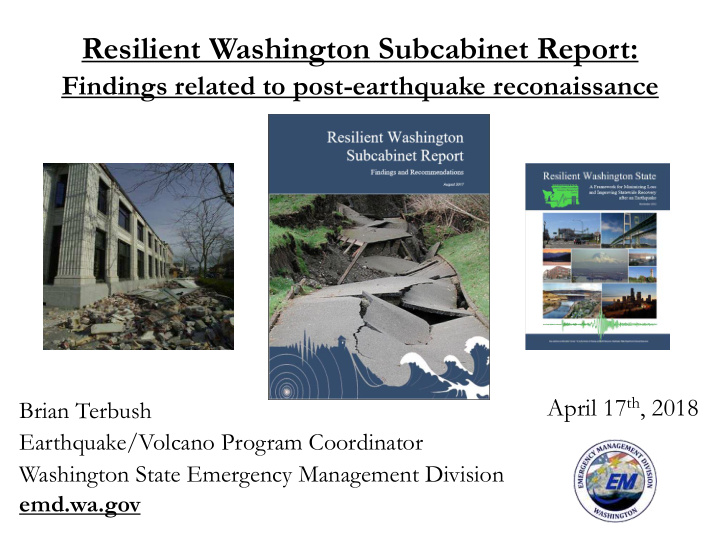



Resilient Washington Subcabinet Report: Findings related to post-earthquake reconaissance April 17 th , 2018 Brian Terbush Earthquake/Volcano Program Coordinator Washington State Emergency Management Division emd.wa.gov
Brief History: • Emergency Management Council • Seismic Safety Committee • 2010-2012: Resilient Washington State Report • June 2016: Cascadia Rising Exercise • November 2016: Governor’s Directive • September 2017: Findings and Recommendations document
Governor’s November 2016 Directive: • Several groups already working on recommendations • Created Subcabinet on resilience to: • Revisit RWS recommendations • Identify key players • Establish current status • Estimate cost/effort to complete actions • Prioritize actions within RWS report • Create a strategy for next steps towards completing the points laid out in RWS Report
Post EQ Reconaissance
Identified Stakeholders: • General Public – Homeowners and Tenants • Building Owners • Private Businesses • Essential Facilities – • Hospitals, Fire, Police, Emergency Operations Centers • Emergency Shelters • Health Care Facilities • Public Works • Prisons • Local Jurisdictions • Schools and Places of Public Assembly
Current Actions: • SSB 5185 signed April 17, 2017, • Extended covered volunteer emergency workers to professional and trade organizations • WA EMD and the WABO addressed liability concerns regarding organizations that train volunteers for post-disaster damage assessments
Current Actions (cont.): • WAsafe Program formalized. • WABO, AIA, SEAW and ASCE. • Enrolling and training qualified volunteers that can rapidly support local jurisdictions in performing post-disaster building safety assessments. • WAsafe integrating into ESF 3 – Public Works and Engineering
Gaps and Barriers WAsafe not currently integrated into ESF 3 - Being corrected
Results: For each recommendation, action items were prioritized based on cost, effort, and priority level From Recommendation 3d: Three action items were given high priority in the short term (0-5 years) Two in medium term(5-10 years):
Short Term (0-5 years) • Develop a volunteer-training curriculum for the WAsafe Program • A proposed training curriculum will be based on the California Office of Emergency Services Safety Assessment Program • customized for use in Washington State by WAsafe volunteers. • Training program must be verified and recognized by WA EMD and FEMA. • Develop and formalize a vetting process for volunteer enrollment through the WAsafe program.
Short Term (0-5years) cont. • Formally integrate the WAsafe program within the ESF-3 structure: • Will allow program members to be part of operational response to a disaster • Will require: • Modification of internal WA EMD processes and practices related to ESFs • MOUs and some reprioritization within WA EMD and DES • Development of deployment procedures • An ongoing state/local training and outreach effort
Mid-Term (5-10 years) • Develop an outreach program informing of the availability of the Building Occupancy Resumption Program (BORP) and Advisory Placard programs, which may allow building owners to rapidly reopen following an earthquake • Will focus on establishing agreements with building officials, qualified private building assessors and private property owners • Project led by volunteers from WABO and WAsafe
Mid-Term (5-10 years) cont. Arrange for WAsafe credentialing and badging of CalOES SAP-trained volunteers to ensure their integration into response actions.
For more information on the process: Many more details on the process in the report appendices. May be downloaded at: https://mil.wa.gov/emergency-management- division/resilient-washington-subcabinet Questions? Contact: Brian.Terbush@mil.wa.gov Maximilian.Dixon@mil.wa.gov
Recommend
More recommend